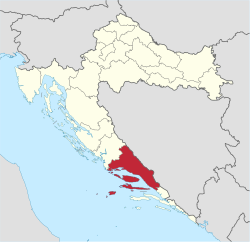
Back مقاطعة سبليت-دالماسيا Arabic Condáu de Split-Dalmacia AST Спліцка-Далмацінская жупанія BE-X-OLD Сплитско-далматинска жупания Bulgarian Splitsko-dalmatinska županija BS Split-Dalmàcia Catalan Splitsko-Dalmatinska Županija CEB Splitsko-dalmatská župa Czech Split-Dalmatia distrikt Danish Gespanschaft Split-Dalmatien German
Split-Dalmatia County
Splitsko-dalmatinska županija | |
|---|---|
 Split-Dalmatia County within Croatia | |
| Country | Croatia |
| County seat | Split |
| Government | |
| • Župan | Blaženko Boban (HDZ) |
| Area | |
• Total | 4,540 km2 (1,750 sq mi) |
| Population (2021)[2] | |
• Total | 425,412 |
| • Density | 94/km2 (240/sq mi) |
| Area code | 021 |
| ISO 3166 code | HR-17 |
| HDI (2022) | 0.871[3] very high · 5th |
| Website | http://www.dalmacija.hr |
Split-Dalmatia County (Croatian: Splitsko-dalmatinska županija [splîtsko-dalmǎtiːnskaː ʒupǎnija]) is a central-southern Dalmatian county in Croatia. The administrative center is Split. The population of the county is 455,242 (2011). The land area is 4.540 km2,[4] the total area is 14.106,40 km2.[5] Split-Dalmatia County is Croatia's most rapidly urbanising and developing region, as economic opportunities and living standards are among the highest alongside capital Zagreb and Istria County.
Physically, the county is divided into three main parts: an elevated hinterland (Dalmatinska zagora) with numerous karst fields; a narrow coastal strip with high population density; and the islands. Parts of the Dinaric Alps, including Dinara itself, form the border with Bosnia and Herzegovina while the Kozjak, Mosor and Biokovo mountains separate the coastal strip from the hinterland.
Important economic activities include agriculture, manufacturing and fishing, though the most important one is tourism.
The county is linked to the rest of Croatia by the newly built four-lane Split-Zadar-Karlovac-Zagreb highway and the Lika railway. Split Airport is the busiest airport in the region.
In the hinterland, the larger towns are Sinj (pop. 11,500 town, 25,373 with villages), Imotski (4,350) and Vrgorac (2,200).
Besides the largest city, Split (189,000 city proper, 250,000 including Kaštela and Solin), the towns on the coast are Trogir (11,000), Omiš (6,500) and Makarska (13,400).
On the islands, the populations are smaller due to high levels of emigration, but are still mostly urban in character. The main townships are: Supetar (3,300) on the island of Brač; Hvar town (3,700) and Stari Grad (1,900) on Hvar; and Vis town (1,800) and Komiža (1,500) on Vis.
- ^ Ostroški, Ljiljana, ed. (December 2015). Statistički ljetopis Republike Hrvatske 2015 [Statistical Yearbook of the Republic of Croatia 2015] (PDF). Statistical Yearbook of the Republic of Croatia (in Croatian and English). Vol. 47. Zagreb: Croatian Bureau of Statistics. p. 62. ISSN 1333-3305. Retrieved 27 December 2015.
- ^ Cite error: The named reference
census2011-ethnwas invoked but never defined (see the help page). - ^ "Sub-national HDI - Area Database - Global Data Lab". hdi.globaldatalab.org. Retrieved 2024-10-10.
- ^ "Census".
- ^ "Splitsko-dalmatinska županija > Županija > Informacije".












